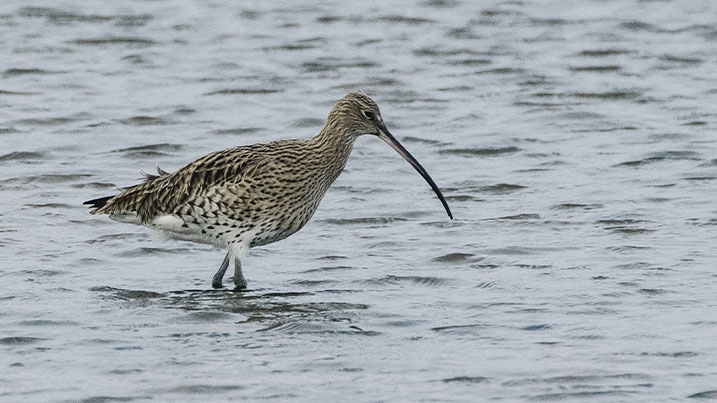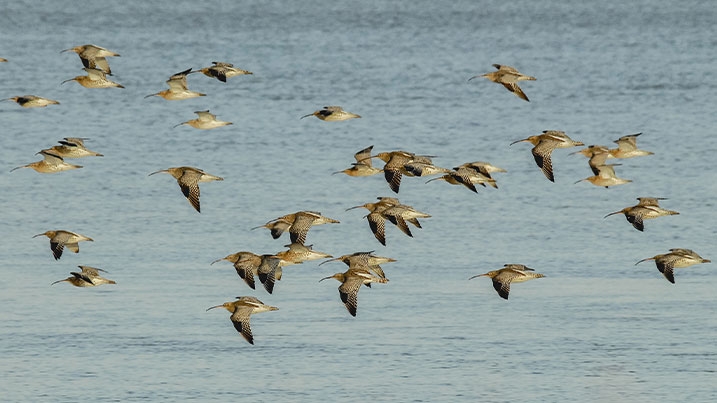Eurasian curlew
Scientific name: Numenius arquata
The UK's largest wading bird and poet's muse, the eurasian curlew, is instantly recognisable by its long legs and distinctive down curved bill.

Species information
The UK’s breeding population of Eurasian curlews is of national importance, being estimated to represent more than 30 percent of the west European population. Yet we’ve lost 65% of our curlews since 1970 due to predation and changing farm practices and they are now Britain’s highest conservation priority bird species.
- Length: 50-60 cm
- Wingspan: 90 cm
- Weight: 770g-1 kg
- Average lifespan: 5 years

Appearance and behaviour
Appearance
Eurasian curlews are mottled brown and grey, with long, bluish legs and a long, down curved bill. Females are larger than males but have the same colouring meaning it can be hard to tell them apart. In flight curlews have a white wedge on the rump.
Curlew behaviours
Curlew shaking water off its back and preening its feathers:
Curlew feeding with its unique down-curved bill:
Diet
Curlews survive on a diet of worms, shellfish and shrimps which they find in the ground through the sensitive touch of their long curved bill. They act like a pair of tweezers or chopsticks to pincer its prey in the mud. They often toss their prey in the air before catching and swallowing, because its tongue can't reach the prey to help flick it down!
Endangered status
Classified in the UK as Red under the Birds of Conservation Concern 4: The Red List for Birds (2015). Priority Species under the UK Post-2010 Biodiversity Framework. Listed as Near Threatened on the global IUCN Red List of Threatened Species.
Breeding/wintering statistics
UK breeding - 66,000 pairs
UK wintering - 140,000 individuals
Curlews breed in diverse habitats and from February to July you can hear their distinctive ‘cur-lee’ over moorland, heath, wet grasslands and farmland. From July onwards they head towards the coast and large estuaries, where they spend the winter.
Curlew facts
- A group of curlews is called a curfew, a salon, or skein of curlews.
- The genus name Numenius refers to the curlew's bill, meaning 'new moon' in reference to the sickle-shaped bill.
- Eurasian curlews used to be eaten, and appeared in several recipe books. They were once so common in Cornwall they were served in pies. In fact, up until 1942, you could still buy curlews in UK butchers.
- Curlews are migratory, but are present all year in the milder climate of the British Isles and the adjacent European coasts.
- Females are larger than males but it can be hard to distinguish between them as their colouring is the same.
- The curlew has undergone a 30% population crash in the last decade due to a number of reasons including predation by generalist predators and loss of habitat for breeding and rearing young.

Where and when to see curlews
Although their numbers are declining, curlew can occur around the whole UK coastline with the largest concentrations found at Morecambe Bay, the Solway Firth, the Wash, and the Dee, Severn, Humber and Thames estuaries.
Greatest breeding numbers are found in North Wales, the Pennines, the southern uplands and the East Highlands of Scotland and the Northern Isles.
Curlews at WWT Wetland Centres
WWT Caerlaverock in Scotland hosts impressive flocks of up to 500 birds from January to March. You can watch the birds probing the ground with their long, curved bills from most of our hides, but the best views are enjoyed from Newfield Hide, Folly Pond Hide and the Farmhouse Tower. Visiting after heavy rainfall when the fields are flooded can provide good views.
WWT Castle Espie in Northern Ireland is a great place to enjoy the curlew’s clear ‘curlee’ call. At their peak in winter, up to 150 birds can be seen feeding along the stream channels on the mudflats, roosting on the Ogilvy and Black Rock islands at high tide, or feeding in the peninsula field. Try the Brent Discovery Hide and the Limekiln Observatory.
Thanks to the food-rich Burry Inlet estuary, WWT Llanelli in Wales is a brilliant spot to see curlews in winter. At high tide, they roost in large flocks of up to 600 birds on the saline lagoons in front of the British Steel Hide. Don’t forget to check the Dafen scrapes behind the hide in case they’re hunting earthworms in the grassland. At low tide, flocks of up to 1,000 curlews can be seen far out on the mudflats probing for worms and crabs. Watch them from the Michael Powell Hide and the observation tower in the visitor centre.
Curlews are a passage migrant and irregular winter visitor at WWT London Wetland Centre. Often glimpsed first thing in the morning around the main lake, grazing marsh and wader scrape, they’re only around for a few hours, maybe using the site to rest and refuel.
The Severn Estuary is an important site for curlews, and around 2,000 to 3,000 curlews depend on the region in winter. WWT Slimbridge in Gloucestershire hosts about 100 to 450 of the birds and you can watch them out on the river and the Dumbles from the Holden Tower, and also on the Tack Piece from the Robbie Garnett Hide.
Curlews are easiest to see during high tides when flocks gather on the edge of the Dumbles to roost, or head inland to the saltmarsh or neighbouring fields to feed, while they wait for the estuarine mud to be exposed again. The tides start coming in around two hours before their peak, so arrive in time to watch the tide rise and the birds begin to move to roost.
From November to January, numbers of curlews at WWT Washington in Tyne and Wear peak at around 900 birds. Your best chance of seeing them is between 3pm and 4pm on dry, frost-free afternoons from the hides overlooking Wader Lake. Diageo Hide and Paddy Fleming Hide offer the best views, though Northumbrian Water Hide and Prince’s Trust Hide can also be good. Look for groups of 50 to 100 birds swooping in and listen for the ‘waffle’ noise created by their rustling feathers.
WWT’s newest reserve in Somerset, Steart Marshes, hosts curlews from September to March, when small numbers feed across the intertidal area. You can usually see one or two from any of the viewpoints over the Marshes. During higher winter tides, larger numbers make their way from Bridgwater Bay into the Marshes, and around 400 birds can be seen roosting together by looking north-east from the horseshoe screen.
How WWT are helping
WWT is at the forefront of plans to help curlews across farmed and lowland areas of England. On World Wetlands Day in 2017, Slimbridge hosted the first Southern English Curlew Workshop. More than 100 conservationists, farmers, landowners, policymakers, scientists and birdwatchers came together to plan the best way to help the few, isolated groups of curlews still surviving in the south of England.
Find out more